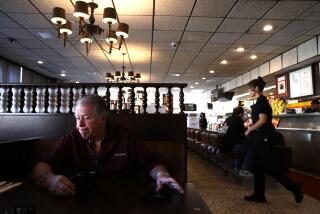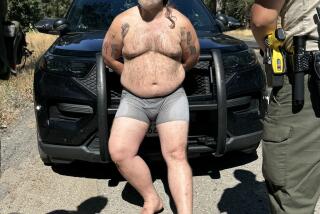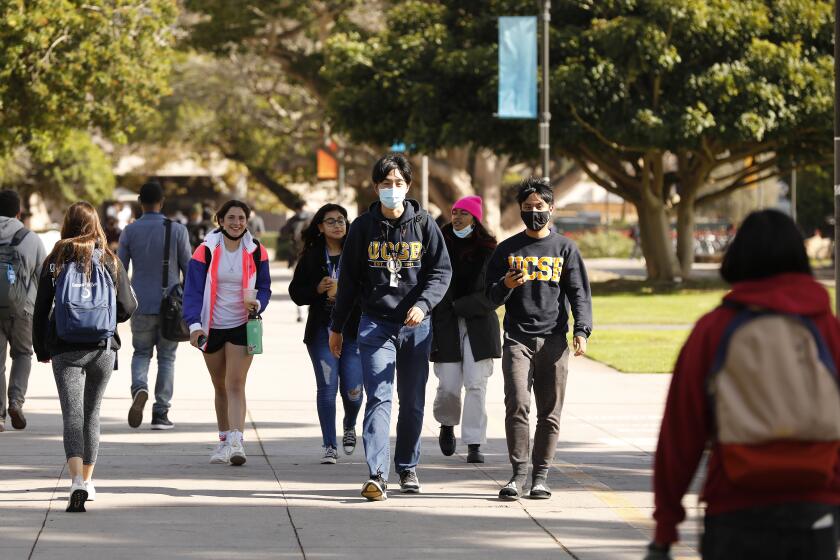No Health Insurance: a Parent’s Nightmare
The fever climbs. The calculations begin.
How bad is it? How bad will it get? Won’t Tylenol do the trick? Or a cool bath, maybe. That always helps. That has to help.
Because there’s just no money for a doctor right now.
It’s painful. So shameful. Your daughter is burning up. And there you sit, wondering: Pawn the TV to pay the pediatrician? Or sell the sewing machine? Or maybe you can pay the electric bill late?
Such are the calculations of the uninsured.
Such is their anguish.
Nearly one in every five kids in California lacks health insurance. That’s 1.7 million children. The Los Angeles County statistics are grimmer still: Almost one in four children is uninsured.
These aren’t the children of single moms on welfare; the majority are not even, technically speaking, poor. If they were, they would qualify for government help. Most of these kids don’t. They are the children of gardeners and salesclerks, of nurses and secretaries, of farmhands and construction workers.
Sixty percent of California’s uninsured children have at least one parent who works full time year-round. Yet many have never been to the dentist.
“I don’t know how to describe what it’s like, being without insurance when you have a child,” said Long Beach mother Catherine Haye. She tries anyway. “It’s a scary feeling,” she said at last. “It really is.”
In a first step toward helping families like Haye’s, the federal government has set aside $24 billion for states to use to insure more children. California will allot part of its share to a program called Healthy Families, a low-cost insurance plan for children of the working poor.
But Healthy Families won’t come close to covering all the state’s uninsured youngsters when it begins July 1. In fact, it will leave out more than a million kids whose family income is either too high or too low for the program.
For them, getting care will continue to mean an expensive trip to the emergency room or a frustrating effort to find lower-cost treatment in the ragged patchwork of programs set up to support the unsupported. It will also depend on luck: whether they live in a town with a good, cheap clinic. Whether they can find a charity willing to help. Whether they hook up with a resourceful school nurse who will work the phones to get them the services they need.
Healthy Families is designed to lift from this limbo only a very narrow group of children: those whose families earn annual incomes starting at the federal poverty line and rising to double that amount. (That works out to $16,050 to $32,100 a year for a family of four.)
For premiums of $4 to $27 a month--depending on family size and income--these parents will be able to buy their kids’ complete medical and dental coverage.
If it works, Maria Meza, a sixth-grader who lives south of Fresno, might be able to tell her mother when she hurts. Now, uninsured, she tries not to complain, even when the asthma strangles her breath. She knows that her father, a fieldworker, has no money for a doctor. So she keeps her troubles to herself.
If it works, 16-year-old Noe Lopez might be able to see an asthma specialist near his South Los Angeles home. No more frantic trips to Tijuana for consultations on the cheap. No more late-night dashes to emergency rooms--and no more $3,000 hospital bills that his folks must pay off in installments, month after agonizing month.
If it works, too, 7-year-old Caitlin Haye might get her roller skates back. Her mom took them away when she lost her insurance, knowing she could never pay for a doctor if Caitlin took a tumble and fractured a wrist.
In short, if it works, Healthy Families for the first time will make health insurance “affordable, sensible and accessible to low-income families,” said Sandra R. Smoley, secretary of the state Health and Welfare Agency.
Citing this potential to transform lives, boosters boast that Healthy Families will be the biggest--and best--health-care initiative to hit California since the federally subsidized Medicaid program to insure poor children arrived in 1965.
New Program Will Leave Out 2 Large Groups
But even if Healthy Families meets its goal of insuring 580,000 children, it will still leave out two significant groups: the poor who qualify for Medicaid but for one reason or another have not enrolled and the lower middle class, who earn too much to enroll in Healthy Families but not enough to buy private insurance.
The program “is a great thing,” said E. Richard Brown, director of the UCLA Center for Health Policy Research, “but we need to be clear about all the kids who aren’t covered.”
Brown estimates that those left out will include nearly 680,000 people under 19 who are eligible for Medicaid, which is known in California as Medi-Cal. Some of these families might sign up for Medi-Cal in coming months, when the state launches an ad campaign to drum up enrollment. But many will no doubt remain uninsured, wary of entanglement with government bureaucracy or unaware that they qualify for care.
In addition, California’s new program will not assist the half a million kids whose parents fall in the wrong income bracket: too rich for Healthy Families, too poor for private coverage.
For all these children, health care will continue to be a scramble, a struggle to tap into the jumble of federal, state and local programs that offer free or low-cost medical care.
If they know where to look, uninsured parents can get their children free physicals and immunizations, and vouchers for $5 prescriptions. They can sign up for low-cost treatments for disabling diseases, from sickle-cell anemia to cancer.
The Lions Club might buy their son glasses--or even pay for eye surgery. Local dentists might fill their daughter’s cavities for free. A volunteer therapist might even step in to counsel a teen through depression.
It sounds like quite a bounty--and it can be. The trick is knowing how to access the services.
And that can be frustratingly tough.
“How incredibly complicated the patchwork of programs for kids is,” Helen DuPlessis, medical director of the Los Angeles Unified School District, said with a sigh.
Some programs bounce families from doctor to doctor and city to city in search of free care. Others, more convenient, are always overcrowded. Much also depends on where families live; some communities are better than others at hooking up uninsured kids with care. In the South Bay, for example, less than half of all uninsured children have a regular health-care provider. In western Los Angeles County, by contrast, nearly three out of four do, according to a recent study commissioned by the county Department of Health Services.
In communities where it’s hard for uninsured patients to link up with the same physician consistently, children “have to navigate a whole new system of care for each need,” said Michael Cousineau, a USC professor of public administration who supervised the county study.
All this adds up to a system that promises generous benefits but too often delivers only confusion.
Residents of Isolated Areas Are Especially Vulnerable
That confusion is evident all over the state, but nowhere more than in the tiny Central Valley town of Huron, where per capita income is just $6,070 a year, about one-third the state average. The valley as a whole has a huge number of uninsured kids; about 17% of those under age 19 have no health coverage. The problem is magnified in Huron, because the town is so small and so remote.
Here, where dirty tufts of cotton from picked-over fields clog the gutters like litter, uninsured parents struggle to understand why they keep bumping into hurdles as they try to tap into a system meant to help them.
Take, for example, the state program known as CHDP, for the California Health, Disability and Prevention Act.
Eligible children can receive free physicals from the program every few years. And if the doctor detects a problem--from a festering cavity to a crooked spine--the program will usually treat it for free.
It sounds like a wonderful deal. Often, it is. But there’s a catch for Huron children, and for residents of isolated towns across the state.
The program requires that free follow-up treatment be conducted only by authorized pediatric specialists. Most of them work in big cities. So kids from rural outposts have to travel for hours just to get to an appointment.
From Huron, for instance, they must trek 60 miles to Fresno. That means their parents--mostly field laborers on hourly wages--must take a day off work to get them care. For many, that’s just not possible. Then there’s the matter of transportation. There’s a once-a-day bus, but its schedule leaves little time for appointments. And the residents with reliable cars charge dearly for their services--up to $60 for a round-trip shuttle. That’s out of reach for most parents.
Even if they do make it to a big-city specialist, children receive limited care under CHDP.
The program pays only for treatment of the specific ailment discovered during the physical. No other illnesses are covered.
Thus, 8-year-old Ana Kristal Avina can get her congenital heart defect examined, since it turned up during a CHDP physical. But her mother, Teresa, has no one to ask why her daughter comes home from school each day feverish and exhausted.
Teresa Avina, a part-time Huron housecleaner, still owes $31 from her last trip to a local clinic--a low-cost facility that works primarily with the uninsured--when Ana’s heart was racing out of control. To her, that bill seems enormous. She cannot afford another. So she treats Ana with anti-fever medicine she brought from Mexico--and prays that all will be well.
“Of course I worry about her,” she said, her face haggard above a peppy flowered T-shirt. “I worry especially about her.”
Although Avina pledges to make sure Ana receives her cardiac care, many low-income parents--already stressed by working too many hours for too little pay--often give up trying to get all that their kids are entitled to.
“We just throw so many barriers at them,” said Neal Halfon, director of the Child and Family Health Program at UCLA. “It’s as if they have to crawl on their knees under barbed wire with their kids on their backs to get in the system.”
School Nurses Play Key Role as ‘Navigators’
In this bruising, bewildering obstacle course, school nurses have emerged as capable navigators. Indeed, it often seems that an energetic school nurse is a child’s best hope for getting connected to the services he or she desperately needs.
Sometimes all it takes is a call, the school nurse on the phone reminding Dad that he really should get Walter’s finger looked at, and why doesn’t he dash over to the hospital health van for a free checkup Thursday?
Sometimes, though, it takes a whole lot more.
“People still think of us as the Band-Aid people,” said Linda Balling, a school nurse in southern Fresno County. In fact, though, school nurses have become case managers. Or as Fontana nurse Valerie Rogers put it: “We’re really health advocates now.”
School nurses know from experience that uninsured children tend to fall behind in academics. Suffering with intestinal parasites or infected gums, many uninsured kids are in too much pain to concentrate in class. Others stay home sick day after day for want of antibiotics.
Medical intervention can make a difference: at Long Beach’s International Elementary School, test scores in language arts, math and reading have rocketed since a medical clinic opened on campus three years ago, said Principal Ruth Ashley.
In schools without such clinics, good nurses make it their business to get students what they need to succeed.
“I get into bartering with the doctors: If I pay half, will you pay half?” said Janet Harrison, who has spent 15 years as a nurse in the San Bernardino County desert town of Adelanto. “You try to do everything you can.”
That includes steering their students to low-cost clinics, making appointments--and driving them there. And stopping by students’ homes after hours to ensure that parents are heeding the proper regimen of medication, therapy and checkups. “You can’t really write a manual for it,” Suzanne Walker, the school nurse in Huron, said. “You just do it.”
The most alert nurses even write notes to remind parents what they should tell the doctor when they finally get to see one.
“When parents use the emergency-room system, they never see the same doctor twice. So there’s no history a doctor can draw on” to assess severity, said Charlotte Brandt, a Bakersfield nurse and president of the California School Nurses Assn. “The parents are often crisis-oriented as well, and so they don’t put it all together unless the school nurse is there in the wings saying, ‘Tell the doctor this is his eighth ear infection this month.’ ”
But even a nurse’s intervention is not always enough.
In the high desert town of Hesperia, nurse Peggy Lindsay said she has been trying for more than a year to get eyeglasses for three middle-school students. Several charities turned her down. No one could provide an exam and glasses for less than $100--which, for the families involved, “might as well be a million dollars,” she said.
Finally, Lindsay thought she had found a solution: The Elks Club arranged for the students to get free glasses through the Loma Linda University Eye Care Center. As always, though, there was a catch--the hospital is south of San Bernardino, about 50 miles from Hesperia.
One mother, Maria Alvarez, tried to take advantage of the offer despite the distance.
Her 13-year-old son, Benjamin, had long been complaining that his eyes ached and his head pulsed with pain. His grades were dropping too. His old glasses, purchased years ago when his dad had health insurance, were too weak to do any good. Not that they fit, in any case. And on his mother’s wages as a part-time janitor and his father’s pay as a pizza delivery driver, the family could not afford a new pair.
Alvarez was hopeful about the Loma Linda offer. But on the day of Benji’s optometrist appointment, her car died. “Just imagine,” she said in frustration. “A problem, always a problem.”
She’s trying now to make another appointment. “It doesn’t matter how,” she promises Benji. Next time, she tells him, “I’ll get there.”
If her car is running, she probably will. She is used to making long trips for health care. Unable to find a doctor in Hesperia to examine her kids for less than $60, Alvarez trundles them all the way to Los Angeles when they fall seriously ill. There, she said, she knows a doctor who will consult--and throw in antibiotics--for $35 a visit.
Those trips, although inconvenient, give Alvarez the continuity that many uninsured parents lack: the same doctor seeing her children every time they’re considerably sick. He knows their history; he has their records on file.
Among the uninsured, that’s a rare benefit.
Instead of coordinating care through a single physician, the uninsured tend to lurch from one provider to another, seeking help only in crises--and then, only when they can afford it. Research has shown that uninsured kids access health care almost as often as children with coverage: 3.8 times a year versus 4.5 times, according to the Urban Institute.
But those statistics may not tell the whole story.
A just-completed survey by the Field Research Corp. found that 41% of all uninsured children in Los Angeles County do not have a regular doctor--compared with just 6% of kids who have private insurance. And that lack of continuity can be a problem.
As UCLA’s Halfon put it: “It’s not the number of doctor’s visits a year that matters, but what it means to have a kid wheezing with asthma at night and no one to call except the emergency room, where no one knows the kid and no one knows his history.”
Arshaunette Shedrick has found out just how frustrating that uncertainty can be since she left a job at United Parcel Service and took a post as a data entry manager.
The new job carries insurance, but it doesn’t kick in for a few months. So when her 10-year-old son, Eddie, started hacking alarmingly, she had nowhere to take him but a local emergency room. The doctor there told her to come back in a few days for reevaluation. But when she returned, no one on duty remembered Eddie--or his cough.
“Before, he had his own doctor who would answer questions over the phone,” Shedrick said. “Now, I have to come here and sit and wait and see what happens. . . . It’s very scary.”
In Some Cities, Clinics for Needy Fill the Gap
In a few fortunate communities, uninsured kids can get the kind of coordinated care that parents with insurance take for granted. At the 58-year-old Long Beach Children’s Clinic, for instance, every patient is assigned to one of five staff physicians. And as the facility’s fliers proclaim in bold letters: “No one is denied care due to inability to pay.”
Under the direction of Dr. Elisa Nicholas, the clinic last year took care of 8,700 pediatric patients--many uninsured--in exam rooms decorated with grinning whales. It also offers a 24-hour hotline to a triage nurse, so even the uninsured have a place to call if a child’s fever spikes in the night.
With the clinic as her ally, Caitlin’s mom no longer has to make her agonizing calculations. She’s even relenting a bit on the roller skates.
“I firmly believe in the power of prayer,” Catherine Haye said. “But sometimes you need mankind’s help too.”
Often, though, such help is out of reach for uninsured parents.
Depending on their income, they might qualify for Emergency Medi-Cal, but that covers only catastrophes. Or they might be able to enroll in Share-of-Cost Medi-Cal, which subsidizes everyday care--but only after families pay a deductible that can top $1,300 a year.
With either program, parents are on their own for all but the most costly illnesses. With no pediatrician on call for advice, they must assess problems themselves. If they misgauge, they pay--one way or another.
If they downplay the illness, telling themselves they can treat it at home, the consequences can be disastrous. An untreated ear infection, for instance, can wreck a child’s hearing. On the other hand, if parents rush to the doctor for every little ache, they can rack up impossible bills.
Black Market Drugs, Homespun Remedies
Consider Edie Simpson, a day-care provider in San Diego who took her 14-year-old daughter to a doctor for tests on a nagging sore shoulder. It turned out to be nothing. “Growing pains,” Simpson scoffed. Yet she and her husband, an air conditioning repairman, are stuck with a $1,000 bill. They’re tackling it in installments--$10 to $15 a month. At that rate, they’ll be lucky to pay it off before their daughter graduates from high school.
Unwilling to risk such a blow, many uninsured parents try their own doctoring.
Some buy Mexican penicillin on the black market or ask friends to bring them drugs from abroad: anything that works from anywhere that’s cheap.
Others stick with homespun remedies. Honey and lemon for a cough. A vapor rub for headaches. For an eye infection, a cleansing with chamomile tea. And a bitter, foul-smelling herb jammed into the ear and plugged with cotton to drive away an ear infection.
“Most parents,” said Raymond Chavarria, director of the Washington Youth Center in one of Long Beach’s poorest neighborhoods, “stay with Grandma’s remedies until it’s a real emergency.”
In the end, for the uninsured, getting timely medical care is often a matter of luck.
Take Virginia Sanchez, who recently moved with her three young children from Mexico to the agricultural town of Kerman, west of Fresno.
It just so happened that Sanchez’s 5-year-old daughter sprouted a rash on the very day she had an appointment for a free physical at a once-a-year clinic for Kerman’s migrant workers. Running his hands over the girl’s inflamed stomach, Dr. James Caffee made an instant diagnosis: scarlet fever.
If Sanchez had not come in for the checkup, her daughter would probably have infected the family--and perhaps the neighbors as well--with the extremely contagious disease. Untreated, scarlet fever can damage a patient’s kidneys or heart valves. And untreated it would have been, had Sanchez not already scheduled a physical that day.
“I would have left her at home,” Sanchez said, helping her daughter tug on her jumper as Caffee jotted down a prescription for free antibiotics. “Thank God this clinic is here.”
Where there are no clinics--or after hours, when the clinics are closed--uninsured parents have little choice but to take their children to an emergency room. Most often, these visits are not true emergencies. In fact, a study by the Robert Wood Johnson Foundation found that trips to the emergency room dropped 70% among kids who enrolled in a low-cost health insurance program through the Florida public schools.
But for now--at least until Healthy Families gets going--the emergency room will continue to be the most handy source of care for uninsured children throughout California.
And so, on a recent Monday night, kids with rattling coughs, unabating fevers and bloody urine filled the plastic chairs in the pediatric emergency room at Los Angeles County’s Martin Luther King Jr./Drew Medical Center. “The Simpsons” was on TV, but no one was watching. The children just sat, looking worn down and weary, until their turn with the doctor.
Waiting hour after hour with his 8-year-old son, who had bashed his shoulder out of joint on a playground, warehouse worker Enrique Velazquez studied the uninsured children around him, including his own shy-eyed boy. He wondered aloud if the system had let them down.
“These are our kids,” he said. “The kids are our future. Or they’re supposed to be.”
(BEGIN TEXT OF INFOBOX / INFOGRAPHIC)
Percentage of Children With No Insurance
Here is a look at the percentage of children age 18 and under who lack health insurance:
United States: 15%
California: 18%
Los Angeles County: 23%
San Francisco Bay Area: 12%
Inland Empire: 18%
San Diego & Orange counties: 21%
Central Valley: 17%
(BEGIN TEXT OF INFOBOX / INFOGRAPHIC)
A Profile of Uninsured Children
Percentage of Californians 18 and under who are uninsured, by race:
Latino: 29%
Asian American: 12%
White: 10%
African American: 10%
Source: UCLA Center for Health Policy Research
*
Jobs with the highest percentage of uninsured workers:
Agriculture: 43%
Construction: 34%
Retail: 26%
Self-employed: 25%
Source: Urban Institute
*
L.A. County residents 17 and under without insurance, by region:
Central Metro: 30
South Central: 32
East County: 20
San Fernando Valley: 25
San Gabriel Valley: 21
South Bay: 22
Antelope Valley: 19
West County: 31
Source: County Dept. of Health Services
*
Of uninsured children in the nation:
Have a parent working full time, year-round: 55%
Have a parent working part time, year-round: 28%
Have parents who do not work: 17%
Live in two-parent families: 63%
Source: Heritage Foundation
*
Uninsured L.A. County residents 17 and under who have not seen a health-care provider for a year or more:
Ages 0-5: 11
Ages 6-12: 20
Ages 13-17: 38
Total average: 20
Source: Los Angeles County Department of Health Services
More to Read
Sign up for Essential California
The most important California stories and recommendations in your inbox every morning.
You may occasionally receive promotional content from the Los Angeles Times.





